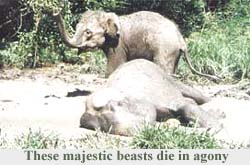
By Sagarika Rajakarunanayake
 "And
one by one, driven to exhaustion, "And
one by one, driven to exhaustion,
trapped by fence and bewilderment,
under an immaculate sky, the creatures died.
They died not in mercy, not in majesty
which was their due, but as the least of life,
accursed of nature.
They died in the dust of insult
and the spittle of lead".
-Glendon Swarthout
On March 21 MTV news showed how in Periankulama, in remote Anuradhapura
North, a she elephant lay fallen in a muddy water hole after suffering
gunshot injuries. Later we learnt that she had been repeatedly shot in
the left leg and back, possibly by farmers. She had suffered great pain
and after lying in the mud for over one week, she died. Staying close to
her was her baby which also had gunshot injuries. After the mother died
it is said to have fled into the jungle.
The veterinary surgeon of the Department of Wildlife Conservation had
started treating her but it was too late. She had been lying injured nearly
a week when he reached her. It would be unreasonable to blame the veterinary
surgeon. He is stationed at Anuradhapura, but he has to single handedly
attend to cases everywhere in the dry zone. Indeed one could not know where
his responsibilities end because he is the only permanently appointed veterinary
surgeon in the DWLC.
This she elephant that suffered an agonizing death is yet one more of
so many hundreds of elephants both, male and female, that despite being
protected by law, have been and continue to be cruelly hunted down, injured
and even destroyed. And the baby elephant is one of hundreds whose mothers
are injured or killed and are either smuggled away by poachers or left
injured to wander back into the jungle alone. In many of these cases there
is no doubt that the mothers and baby elephants could have been saved had
the DWLC provided prompt and effective veterinary attention to the animals.
Would anyone believe that at present there is only one veterinary surgeon
permanently employed by the DWLC and working regularly in the field ? He
is stationed at Anuradhapura. The dry zone districts, Anuradhapura, Polonnaruwa,
Puttalam, Kurunegala, Amparai and Moneragala all can be said to be highly
critical areas where the human-elephant conflict is concerned, and each
one has a high rate of elephant casualties. The conflict can be said to
be no less critical in other districts in the country.
In 1994 when the present minister took over the subject of wildlife
conservation, it was found that the DWLC had been functioning for the past
twelve years without the services of even a single permanently appointed
veterinary surgeon. The Director of the DWLC, appointed by the new minister,
asked for a cadre of seven veterinary surgeons. In 1996 the Department
was granted five veterinary surgeons to the permanent cadre. The minister
gave his consent to begin recruiting the full complement of veterinary
surgeons without delay.
Strangely, thereafter, the then Director, successive directors and ministry
officials have adopted a lethargic attitude to this issue, despite the
urgent need in the field. We understand that recently two new veterinary
surgeons were recruited to the Department. However, one of them, for some
incomprehensible reason, is said to have been sent to the Peradeniya Veterinary
Faculty for extra academic training, when what is required is training
in the field, on the job, conducted by the DWLC. The second recruit we
learn will not be taking up his appointment in the DWLC.
The DWLC faces the problem of veterinary surgeons not showing much interest
in joining the Department. The fact is that the DWLC offers to veterinary
surgeons an unattractive salary and no prospects of promotion. There is
no recognition of the risks and difficulties under which they are called
on to work.
The Department must heed the concern of the public, and open its eyes
to the cruelties and suffering faced by injured animals in the wild due
to trap guns etc. Without veterinary assistance these animals sometimes
linger in agony for weeks or months before they die.
(The writer is President, Sathva Mithra)
|




 "And
one by one, driven to exhaustion,
"And
one by one, driven to exhaustion,